Abstract
Eight females and eight males participated each in 4 comfort experiments on 4 different days. Two experiments took place in the morning and two in the evening. In each experiment (21/2 hours) the preferred ambient temperature was determined for each subject by adjusting the ambient temperature according to his wishes. The subjects were sedentary. Skin temperatures, rectal temperature and evaporative weight loss were measured.
Although the rectal temperature and the mean skin temperature were slightly higher in the evening than in the morning the subjects did not prefer an ambient temperature which was different from that in the morning. This indicates that the same thermal comfort conditions can be used from morning to evening.
Zusammenfassung
Acht Frauen und 8 Männer dienten als Versuchspersonen in 4 Behaglichkeitsprüfungen an verschiedenen Tagen mit 2 Untersuchungen morgens und 2 abends. In jedem Versuch von 2, 5 Std. Dauer wurde die von der Person gewünschte Behaglichkeitstemperatur ermittelt. Die Personen sassen; die Haut- und Rektaltemperaturen sowie der Gewichtsverlust durch Evaporation wurden während der Zeit registriert. Obwohl die Rektal- und mittlere Hauttemperatur am Abend leicht höher waren als am Morgen, wählten die Personen abends die gleiche Temperatur wie morgens. Unter Einbeziehung von Ergebnissen früherer Untersuchungen ergibt sich, dass vom Morgen bis zum Abend die gleichen Wärmebedingungen für die Behaglichkeit des Menschen gehalten werden können.
Resume
4 jours différents, 8 femmes et 8 hommes ont participé chacun à 4 essais sur les conditions de confort. 2 de ces essais avaient lieu le matin et 2 le soir. A chaque essai (d'une durée de 2, 5 heures), la température ambiante la plus judicieuse a été déterminée pour chacun des sujets par réglage au gré de ses désirs. Le sujet était alors assis. Pendant l'essai on a mesuré les températures cutanée et rectale ainsi que la perte de poids due à l'évaporation. Bien que les températures rectale et cutanée aient été légèrement plus élevées le soir que le matin, les sujets n'ont pas reclamé, le soir, une température ambiante supérieure à celle du matin. En liaison avec le résultat d'études antérieures, on peut en conclure que des conditions uniformes de confort thermique peuvent être appliquées du matin au soir.
Similar content being viewed by others
References
FANGER, P.O. (1967): Calculation of thermal comfort: Introduction of a basic comfort equation. ASHRAE Trans., 73, (II): III.4.1-III.4.20.
FANGER, P.O. (1973): Thermal Comfort. McGraw-Hill, New York, 244 pp.
FANGER, P.O., HØJBJERRE, J. and THOMSEN, J.O.B. (1974): Man's preferred ambient temperature during the day. In: Prévision quantitative des effects physiologiques et psychologiques de l'environnement thermique chez l'homme. Collection des Colloques Internationaux du C.N.R.S., 15 Quai Anatole France, Paris. (In press).
FANGER, P.O. (1974): The variability of man's preferred ambient temperature from day to day. In: Prévision quantitative des effets physiologiques et psychologiques de l'environnement thermique chez l'homme. Collection des Colloques Internationaux du C.N.R.S., 15 Quai Anatole France, Paris. (In press).
GAGGE, A.P., WINSLOW, C.-E.A. and HERRINGTON, L.P. (1938): The influence of clothing on physiological reactions of the human body to varying environmental temperatures. Amer. J. Physiol., 124: 30–50.
GAGGE, A.P., RAPP, G.M. and HARDY, J.D. (1964): Mean radiant and operative temperature for high-temperature sources of radiant heat.ASHRAE Trans., 70: 419–424.
GAGGE, A.P., HARDY, J.D. and RAPP, G.M. (1965): Exploratory study on comfort for high temperature sources of radiant heat. ASHRAE Trans., 71 (II): 19–26.
HARDY, J. and DUBOIS, E.F. (1940): Differences between men and women in their response to heat and cold. Proc. Nat. Acad. Sci. (Wash.), 26: 389–398.
NEVINS, R.G., ROHLES, F.H., SPRINGER, W. and FEYERHERM, A.M. (1966). A temperature-humidity chart for thermal comfort of seated persons. ASHRAE Trans., 72, (I): 282–291.
OLESEN, B.W. and FANGER, P.O. (1974): The skin temperature distribution for resting man in comfort. In: Prévision quantitative des effets physiologiques et psychologiques de l'environnement thermique chez l'homme. Collection des Colloques Internationaux du C.N.R.S., 15 Quai Anatole France, Paris. (In press).
OLESEN, S. and FANGER, P.O. (1971): Can man be adapted to prefer a lower ambient temperature? In: Proceedings of Fifth International Congress for Heating, Ventilating and Air-Conditioning. H.Salmark (ed.), Polyteknisk Forlag, Copenhagen, I: 27–40.
OLESEN, S., BASSING, J.J. and FANGER, P.O. (1972): Physiological comfort conditions at sixteen combinations of activity, clothing, air velocity and ambient temperature. ASHRAE Trans., 78, (II): 199–206.
ROHLES, F.H. and NEVINS, R.G. (1971): The nature of thermal comfort for sedentary man. ASHRAE Trans., 77, (I): 239–246.
Author information
Authors and Affiliations
Rights and permissions
About this article
Cite this article
Fanger, P.O., Højbjerre, J. & Thomsen, J.O.B. Thermal comfort conditions in the morning and in the evening. Int J Biometeorol 18, 16–22 (1974). https://doi.org/10.1007/BF01450661
Received:
Issue Date:
DOI: https://doi.org/10.1007/BF01450661




